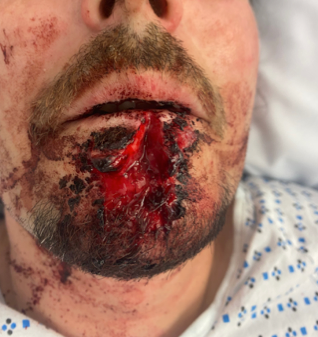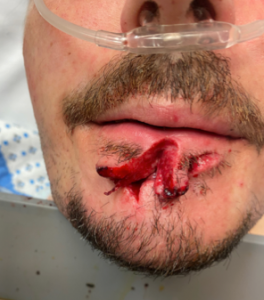Lower lip and chin laceration
History:
A 37 year old man sustained a chin and lower lip laceration crossing vermilion from a motor vehicle accident. He had lost consciousness at the scene but was alert and oriented in the ED. He denied any other injuries. He reported minimal bleeding from his chin and lower lip that was controlled with pressure. Patient was up to date on his T-DAP-vaccinations. Head/spine CT and basic labs were obtained by the emergency department as part of their trauma work up. The Plastic and Reconstructive Surgery team was consulted for the chin and lip laceration as it crossed the vermillion border.
Findings:
On exam, a stellate deep laceration to lower lip and upper chin with exposed orbicularis muscle and including vermilion border was found. The wound was covered with dry blood and debris. There was no loss of teeth or evidence of facial fractures.

Figure 1. Shows lower lip and chin laceration covered with debris.

Figure 2. Shows the laceration after copious washout.
Diagnosis:
Complex laceration of chin and lower lip including vermilion border.
Differential Diagnoses:
R/O injury to mandible, teeth or other facial bones.
Workup Required:
Cranial Nerves 2-11 were examined and were without deficit. No intraoral lacerations, malocclusion, or loose teeth were noted on exam. Verbal consent was then obtained for irrigation, debridement, and closure of his lacerations.
Plan:
Repair of the laceration under regional anesthesia in the Emergency Department.
Expertise Needed:
Plastic Surgeon
Treatment:
The patient was placed in the supine position with good lighting. The wound was copiously irrigated with NS and betadine solution. In the muscle, 4-0 Monocryl sutures were used for approximation. In the vermilion and mucosa Chromic was chosen to avoid pain associated with their removal. In the superficial layer, 6-0 Monocryl sutures were used to approximate the skin edges. Due to patient compliance concerns and potential for not returning to clinic for sutures removal, 6-0 Chromic interrupted sutures were used for the skin approximation. Bacitracin was applied to the wound and the patient was instructed to apply Bacitracin ointment twice daily until follow up. He was also instructed to avoid sun exposure and use SPF-30 or higher lotion if exposed to sun for the next year. This was done in order to decrease the risk of differential pigmentation of his scar. He received 5 days of prophylactic antibiotics. He was scheduled for follow up in 1 week for wound check. Unfortunately, he did not show up for his follow up visit.
Follow Up:
Unfortunately, he did not show up for his follow up visit.

